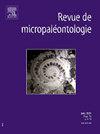Actinomma sogndalensis n. sp. (Radiolaria, Polycystina) an endemic species to the Sognefjord, western Norway
IF 1
Q4 PALEONTOLOGY
引用次数: 0
Abstract
Studies of polycystine radiolarians (marine planktonic protists) have shown that great faunistic differences occur between the different Norwegian fjord systems. Plankton studies by Swanberg and Bjørklund in the early 1980′s identified more than 55 polycystine radiolarian species, including two unidentified forms of Actinomma noted as sp. A and sp. B. The discovery of fully developed adult individuals of the same taxa in plankton material from the Sogndalsfjord in 2010 revealed that the sp. A form in fact was a juvenile stage of the sp. B form. Its general morphologic skeletal structure differs so much from the other local Actinomma species that the whole concept of how to define, and what to include in, this genus has been taken up here for discussion.
This new species, described herein as Actinomma sogndalensis, has mainly been found in the Sognefjord, which leads us to conclude that A. sogndalensis might be an example of a real endemic fjord species. Due to the fragility of the latticed cortical shells, only the two thick primary medullary shells are preserved in the sediment. This led us to include a discussion regarding the number of concentric shells and their relevance or usefulness as a taxonomic criterion at the genus level in conjunction with this description of the new species. The genus Actinomma is emended to include species with two or multiple lattice spheres. Cromyechinus is by us still regarded as a junior synonym of Actinomma.
放线菌sogndalensis n. sp.(放射菌属,Polycystina):挪威西部Sognefjord的特有种
对多胱氨酸放射虫(海洋浮游原生生物)的研究表明,在挪威不同的峡湾系统之间存在着巨大的动物群差异。Swanberg和Bjørklund在20世纪80年代早期的浮游生物研究中发现了超过55种多胱氨酸放射虫,其中包括两种未识别的放线虫,分别被称为sp. A和sp. B。2010年在sogndalsjord的浮游生物材料中发现了同一分类群的完全发育的成年个体,这表明sp. A实际上是sp. B形式的幼年阶段。它的一般形态骨骼结构与其他本地放线菌物种有很大的不同,因此如何定义这个属的整个概念,以及该属包括什么,在这里进行了讨论。该新种主要在Sognefjord发现,本文将其命名为Actinomma sogndalensis,这使我们得出结论,a . sogndalensis可能是真正的峡湾特有物种的一个例子。由于格状皮质壳的脆弱,沉积物中只保留了两个厚的初级髓质壳。这导致我们在对新物种的描述中加入了关于同心壳的数量及其作为属一级分类标准的相关性或有用性的讨论。放线菌属被修正为包括具有两个或多个晶格球的种。Cromyechinus仍被认为是放线虫的低级同义种。
本文章由计算机程序翻译,如有差异,请以英文原文为准。
求助全文
约1分钟内获得全文
求助全文
来源期刊

REVUE DE MICROPALEONTOLOGIE
PALEONTOLOGY-
CiteScore
2.50
自引率
0.00%
发文量
17
期刊介绍:
La Revue de micropaléontologie publie 4 fois par an des articles de intérêt international, consacrés à tous les aspects de la micropaléontologie. Les textes, en anglais ou en français, sont des articles originaux, des résultats de recherche, des synthèses et mises au point, des comptes rendus de réunions scientifiques et des analyses de ouvrages. La revue se veut résolument ouverte à tous les aspects de la micropaléontologie en accueillant des travaux traitant de la systématique des microfossiles (et de leurs équivalents actuels), des bactéries aux microrestes de vertébrés, et de toutes leurs applications en sciences biologiques et géologiques.
 求助内容:
求助内容: 应助结果提醒方式:
应助结果提醒方式:


